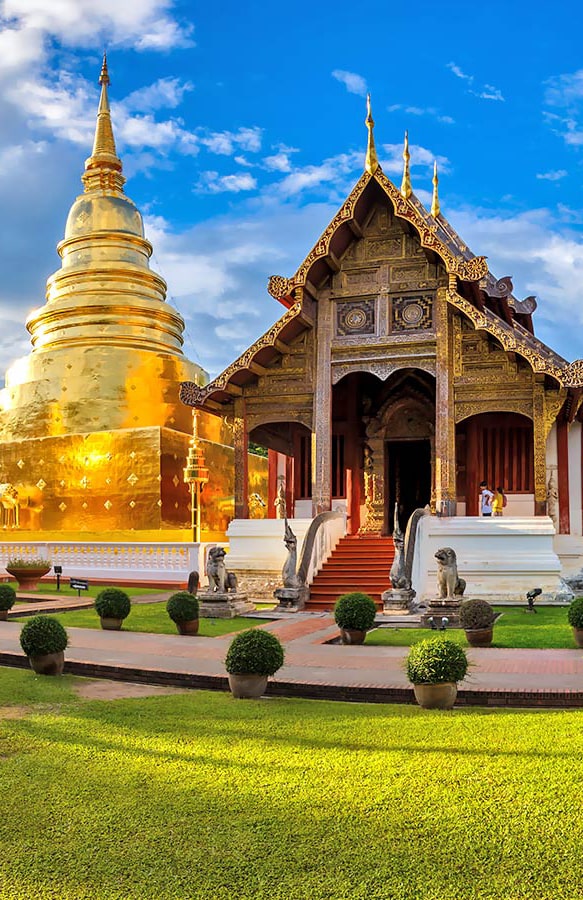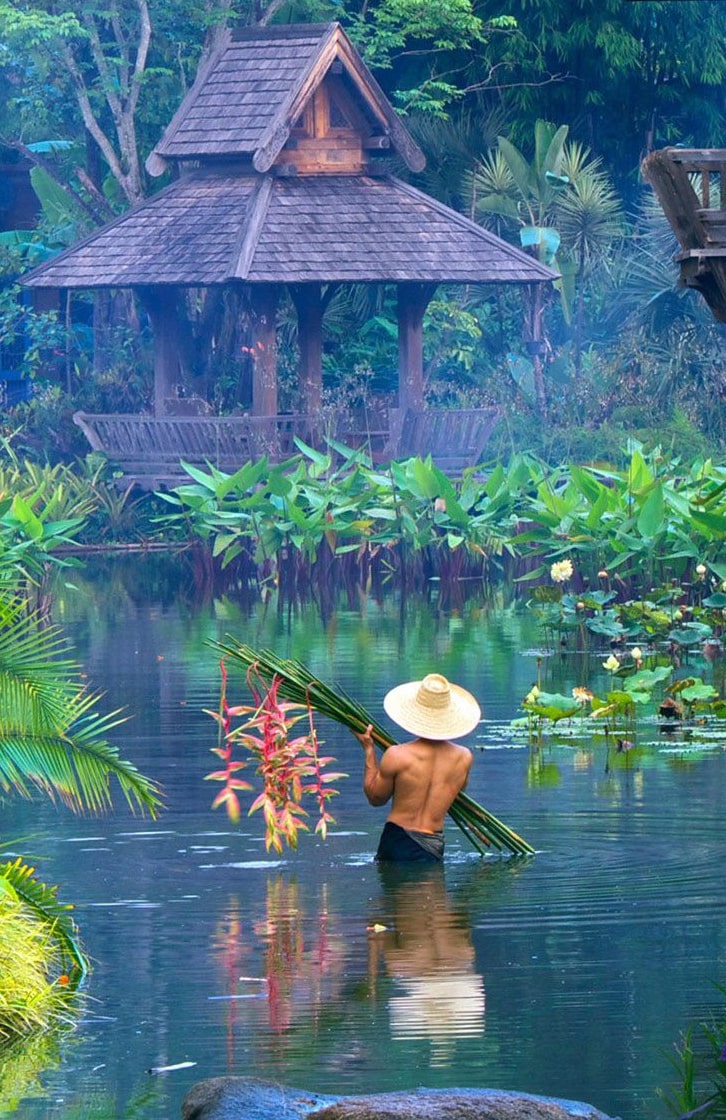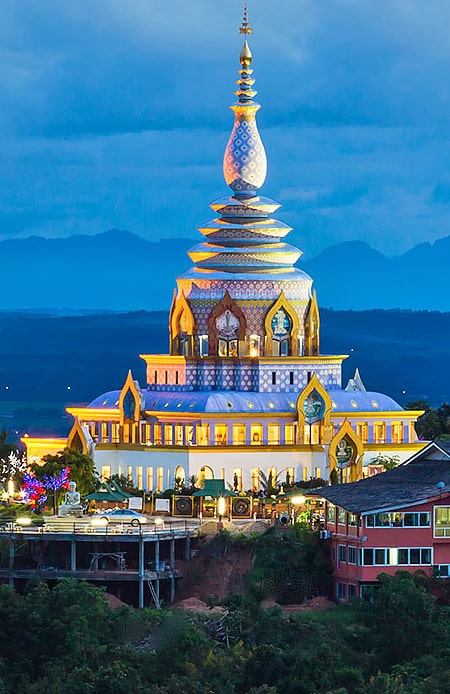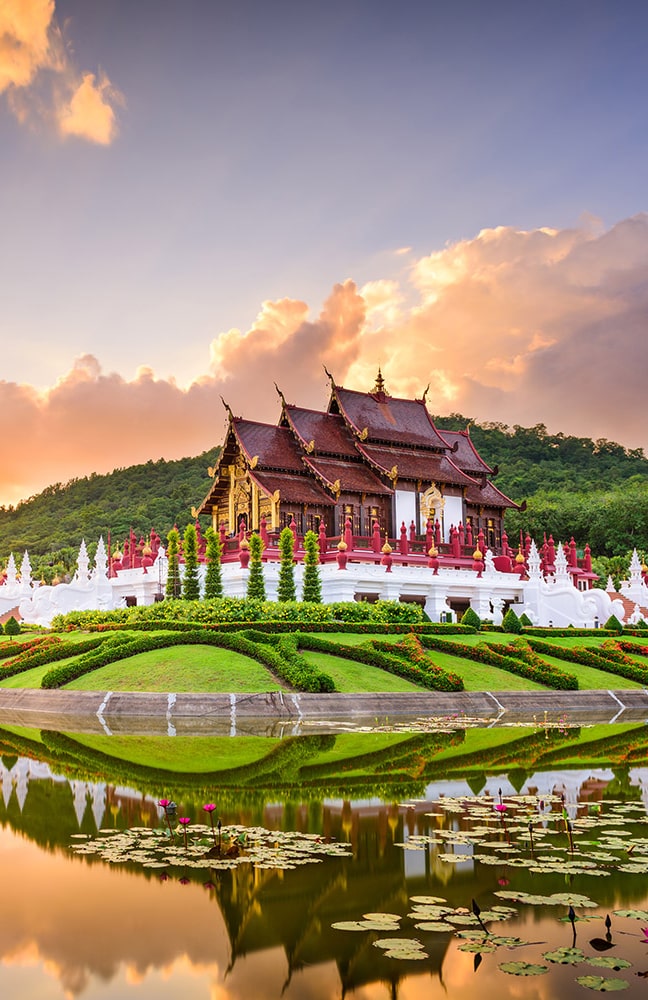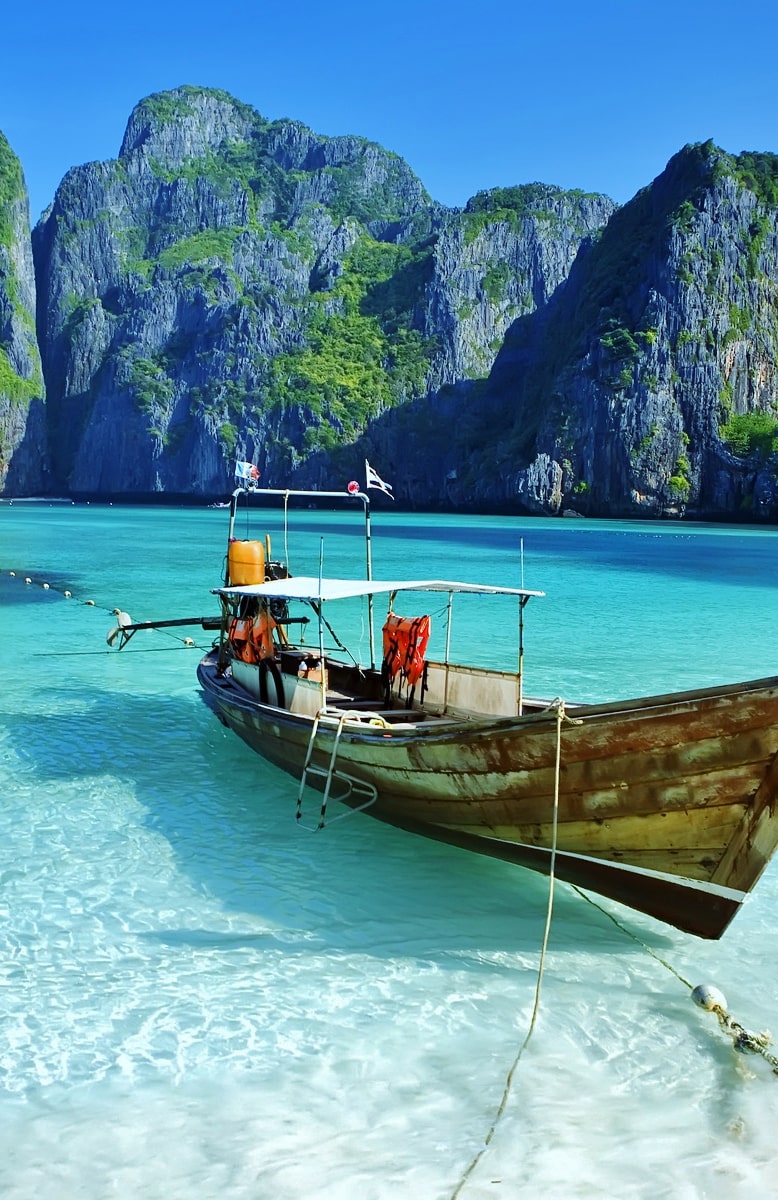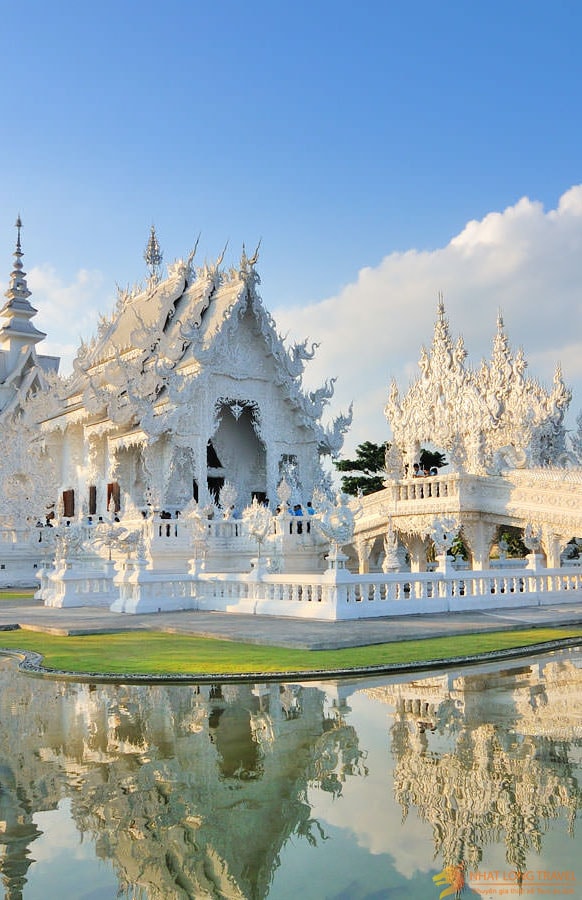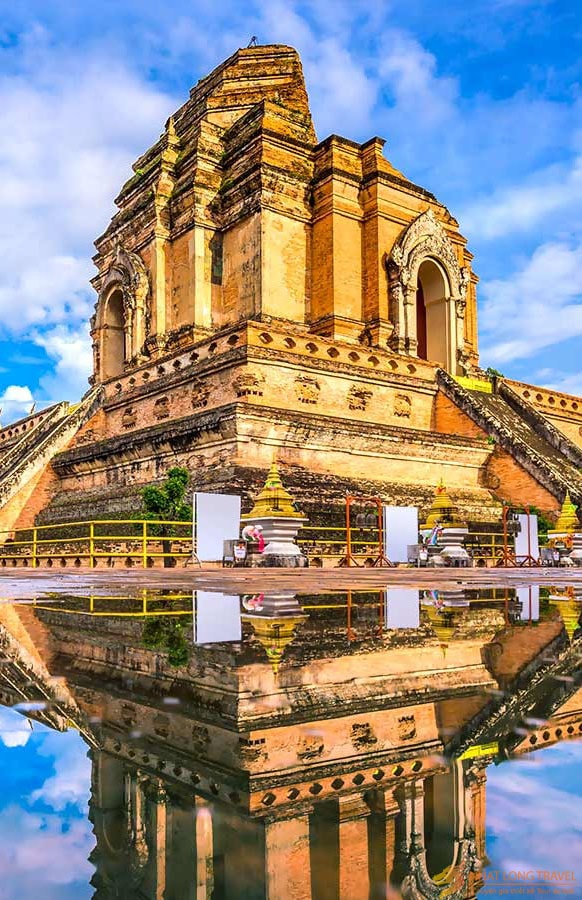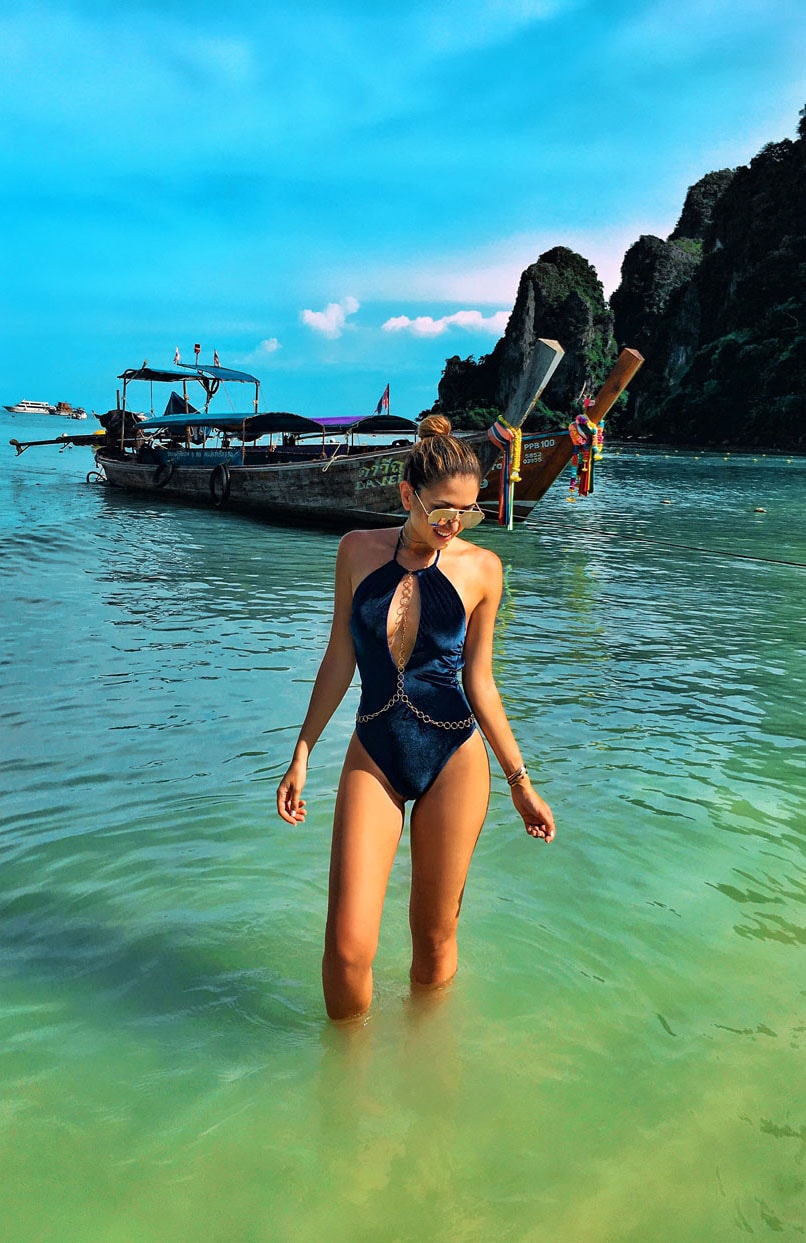Thailand
Explore Our Thailand Tours
Explore Our Thailand Tours

Asia Master Tours
Travel Guide
SAWATDEE!
The Buddhist country of Thailand remains one of Asia’s most popular vacation destinations. This is a land full of smiling faces and enchanting places, combining a fast and vibrant nightlife with peace and quiet retreats spots.
Bangkok, the capital city will definitely seduce travelers with such different flavors and colors, royal palaces, glittering temples, and exciting markets along the city’s canals. Although the spiritual essence of Thailand is strong and its people modest, it is nonetheless a luxury destination in Southeast Asia with plenty of incredible accommodations in its major cities and paradisiacal beaches. Indeed, Thailand is a destination with a wide array of luxury experiences whether it be in lavish bungalows secludes on a remote island, mountain top villas or exclusive penthouse suite atop glittering skyscrapers.
Recommended for beach and romantic getaways, wellness and spa holidays as well as family vacations.
Thainess, or the art of hospitality served by the Thai Heart and Thai Smile.
Treasures and the historical heritage sites and golden temples of Thailand. The best places to go to are Ayutthaya, Sukhothai and Bangkok.
Beaches, as Thailand is blessed with natural beauty and offers some of the most scenic and beautiful beaches and islands in the world. The most recommended places for a beach holiday are Phuket, Koh Samui, Koh Samet, Koh Chang, Koh Phi Phi, Koh Lanta, Hua Hin and Pattaya.
Nature, that will amaze travelers with greenish beauty of its National Parks and many waterfalls. For that, we recommend places such as Kanchanaburi, Mae Hong Son, Khao Yai, Chiang Mai or Chiang Rai.
Wellness, with plenty of Preventive and Curative Therapy culture. There you can be introduced to the miracles of natural procedures and holistic treatments for the body and soul. This includes a variety of world renowned spas, medical spas, clinics and specialized hospitals all along with the Thai traditional massage and therapies.
What can I do in Bangkok?
Thailand’s capital, Bangkok is a large city all about colors, smells and flavors emaning from its street life and bustling Markets. The main attractions are the sparkling golden temples and buddhas surrounded by the tranquil Chao Phraya River. The vast choice of Thailand’s capital will not disappoint you.
Among its unmissable spots are the opulent Grand Palace and the Wat Phra Kaew Temple. Nearby will be the Wat Pho temples famous for its reclining Buddha and right oposite beyond the Chao Phraya stand the Wat Arun temple or temple of the Dawn so named because the first light of the morning reflects off the surface of the temple with pearly iridescence.
What can I do in Phuket?
Phuket is a rain forested and mountainous island in the Andaman Sea home to many luxury resorts and high end services such as Spa or restaurants. Phuket is one of the most famous destinations in Thailand for its dramatic karst islands and relaxed beaches. Its most popular beaches are Rawai, Patong, Karon, Kamala,Kata Yai and Kata Noi and Mai Khao. Phuket province consists of the country’s largest island and another 32 small islands off its coast where you can practice diving, beach-bumming, spa and holistic treatments of fabulous food tasting.
Swim around dramatic karst islands on relaxed beaches
CENTRAL AND EASTERN THAILAND
There are 26 provinces that make up Central and Eastern Thailand, and Bangkok is one of them. Geographically, this is Thailand’s heartland, extending from Lop Buri in the north and covering the rice bowl of the Central Plains around the Chao Phraya River. Further south, the area embraces the east and west coasts of the upper Gulf of Thailand.
This is Thailand’s most fertile farming area, a wide-ranging landscape of paddy fields, orchards and plantations. More than 1,000 years ago, Thai settlers moved down from the north, gradually replacing Mon and Khmer influences and establishing communities at Lop Buri then at Sukhothai, before founding a kingdom that lasted 417 years with Ayutthaya as its capital. When the Burmese destroyed Ayutthaya in 1767, the capital moved to Bangkok.
The Central region has a dramatic history, and has been home to ancient temples, battlefields, many ruins, and its two capitals (Ayutthaya and Bangkok) are a continuing fascination for visitors. The east and west sea coasts at the region’s southern end also draw huge numbers of visitors every year. Bangkok residents spend long weekends enjoying the relaxing seaside atmosphere, while holiday-makers from around the world discover the delights of tropical beach life.
On the eastern side, 400 kilometres of coastline extend from Chon Buri to Rayong, with some of the finest beaches in Asia. Pattaya, with an enormous range of resorts, hotels and guesthouses, is its centre. If you are seeking a more relaxing experience, travel further down the coast to Rayong or Ko Samet, and the lovely islands of Ko Chang National Park near the Cambodian border.
On the west coast, the resorts of Cha-am and Hua Hin attract international travelers who prefer the more sophisticated yet laid-back atmosphere.
Far from the sea, in the northwest of the region, is Kanchanaburi, whose forested mountains, waterfalls, caves, national parks and wildlife sanctuaries on the border with Myanmar provide some of Thailand’s most enthralling scenery.
THE NORTH
The North is the birthplace of the earliest Thai civilisation and has many sites of archaeological and cultural interest. Northern people are famous for their courtesy and hospitality, and the region is also noted for its variety of cultural traditions. Many tourists from the surrounding provinces converge on Chiang Mai for the annual Songkran Festival, and to Sukhothai for Loi Krathong.
The North falls into two distinct areas, the plains of the lower north from Nakhon Sawan to Sukhothai, and the mountainous upper north leading to the borders of Myanmar and Laos. The mountain ranges along the borders are breathtaking, with waterfalls and fast-flowing rivers ideal for rafting. They are also the home of many ethnic hill people.
THE NORTHEAST
The northeast of Thailand, a vast plateau covering nearly one third of the country, is usually known as Isan. It extends northwards to the Mekong River which divides Thailand from Laos, and to the south and it ends at the Dong Rek mountain range along the border with Cambodia.
It is known to be an arid region with soil of poor quality, but for tourism, Isan is one of the country’s most intriguing destinations with many Stone Age and Bronze Age dwellings and artifacts, and several significant temples that are a legacy of the great Khmer empire.
The sandstone shrines are popular tourist attractions, particularly the superbly restored sites at the historical parks of Phimai in Nakhon Ratchasima and Phanom Rung in Buri Ram. The great temple complex at Khao Phra Viharn in Si Sa Ket, on the border with Cambodia, is now accessible to visitors after a long period of isolation.
Two of Thailand’s best-loved national parks (Khao Yai, Phu Kradung and Phu Rua in Loei) are in Isan. Other major attractions include the villages in Khorat and Khon Kaen, where beautiful silk is woven by hand. Isan is a comparatively poor region, whose main income is from agriculture, and many of the younger people in the villages migrate to the city. But Isan folk have a distinctive character and dialect and a vigorous culture, with their old traditions still reflected in the many festivals unique to the region.
With its strategic position bordering Laos and Cambodia, Isan has in recent years risen to become a useful starting point for adventurous journeys to destinations along the mighty Mekong River. There have been important developments in infrastructure to accommodate what is expected to be a boom in tourism.
THE SOUTH
This region extends southward along a narrow peninsula lying between the Andaman Sea on its west side and the South China Sea on the east. It is a rich land in terms of the abundance of its natural resources, the fertility of its soil, the diversity of its people and its commercial viability.
The South is made up of 14 provinces from Chumphon in the north down to the Malaysian border, 1,200 kilometres from Bangkok. It has a long coastline on either side, with sandy beaches and offshore islands on both, and a rugged central hinterland of mountains and forests.
The east coast on the Gulf of Thailand always seems to be more relaxed, with long, wide bays and calm seas. The Andaman Sea coast tends to be more rugged and exhilarating, with its strange limestone rock formations and cliffs.
The coastline attracts most tourists, though Samui Island in the Gulf of Thailand is growing in popularity as a laid-back holiday spot with first class diving opportunities nearby on Tao and Pha-ngan islands.
The mountains, rivers and forests in the national parks in the interior of the peninsula are also gaining popularity with eco-tourists, as can be seen with the growing numbers of safari expeditions on foot, by elephant and in canoes.
In Thailand, Thai serves as the official national language. English is taught in schools and colleges and is also used in academia, commerce, and government. Not surprisingly English is widely spoken in Thailand in the tourist industry. Guides and hotel and restaurant employee often speak English in varying degrees of fluency. Off the beaten track few people speak English well. More people are leaning English all the time and those who speak it well enough to engage in a conversation relish the opportunity to speak it with native English speakers.
Chinese New year
12nd to 16th of April Songkran Festival New Year
15th of October Passing of King Bhumibol
Thai Baht is accepted everywhere and currency exchange booths are available around Bangkok in banks across Thailand. While major credit and debit cards are also accepted in most establishments and shopping centers, there are occasionally additional fees from both the retailer and your card provider. Travelers cheques can be cashed at most banks throughout Thailand though less so at retail establishments.
ATMs for withdrawing Thai Baht are widely available in major airports, shopping malls, hotels, and almost all provincial banks in Thailand. For most banks there is a maximum withdrawal of 20,000 THB per transaction, however, several withdrawals may be made in a single day. Ask your tour guide for help when you need to locate an ATM.
No vaccinations are required unless you are coming from contaminated areas. Malaria in Thailand is not as common as in neighboring countries, though Malaria (and some of the most virulent strains) is prevalent along the border regions, particularly near Cambodia and Laos. Medications for malaria do not prevent you from getting infected with malaria; they simply better prepare your immune system in the event of infection. Consequently, those not traveling to high risk zones do not need to take medication
Internet
Internet cafes are widely available everywhere and are easily found in major towns and cities.
Trading Hours
Most businesses are open from Monday to Friday. Government offices are open from 08:30 to 16:30, with some closing for lunch from 12:00 to 13:00. Many retailers and travel agencies are also open on Saturday and most shops are open on Sundays. Our Luxury Travel office hours are from 09:00 to 18:00 daily and from 10:00 to 16:00 on Sundays.
What to bring fromThailand?
Thai silk, soap, thai carvings, jewellery, Thai handicrafts, art and home décor, coconut oil, Thai spa products, everything made from coconut, cocounet jam, lights and lanterns. Jewelry and gemstones from Thailand are the favorite items for many visitors to the kingdom. Their beauty, quality craftsmanship and reasonable prices have earned Thai precious and semi-precious stones a worldwide reputation.
Bargaining
Fixed prices are the norm in department stores, but at most other places bargaining is to be expected. Generally, you can obtain a final figure of between 10-40% lower than the original asking price. Much depends on your skills and the shopkeeper’s mood. But remember, Thais appreciate good manners and a sense of humor. With patience and a broad smile, you will not only get a better price, but you will also enjoy shopping as an art.
V.A.T. Refunds: Visitors entering the Kingdom on a tourist visa are entitled to a refund of the 7% V.A.T. on goods purchased at registered retail outlets.
Thailand uses 220V (50 cycles per second) but the plugs are not standardized. It is recommended that you bring a universal plug adaptor.
Tipping is not a usual practice in Thailand although it is becoming more common. Most hotels and restaurants add a 10% service charge to the bill. Taxi drivers do not require a tip, but the gesture is appreciated and 20-50 baht is acceptable for porters. In restaurants it is common for Thai’s to leave the coins as a tip, though an additional 20-100 baht is not unheard of in nicer establishments, particularly if the service is good.
Thais don’t normally shake hands when they greet one another, but instead press the palms together in a prayer-like gesture called a “wai”. Generally, a younger person wais an elder person, who then returns the gesture.
Thais regard the head as the highest part of the body, literally and figuratively. Therefore, avoid touching people on the head and try not to point your feet at people or an object. It is considered very rude. Shoes should be removed when entering a private Thai home.
Public displays of affection between men and women are frowned upon.
The Monarchy: Thai people have a deep, traditional reverence for the Royal Family, and a visitor should be careful to show respect for the King, the Queen and the Royal Children.
Religion: Visitors should dress neatly in all religious shrines. They should never go topless, or in shorts, hot pants or other unsuitable attire. It is acceptable to wear shoes when walking around the compound of a Buddhist temple, but not inside the chapel where the principal Buddha image is kept.
Each Buddha image, large or small, ruined or not, is regarded as a sacred object. Never climb onto one to take a photograph or do anything which might indicate a lack of respect. Buddhist monks are forbidden to touch or be touched by a woman, or to accept anything from the hand of one. If a woman has to give anything to a monk, she first hands it to a man, who then presents it.
It very much depends on each individual traveler’s priorities. Some might want nothing but sunshine and beaches with little worry for cost and head there during the high season.
Others on a tighter budget, or simply wishing to avoid the crowds, might prefer to go during the rainy season. With lots of special hotel deals on offer, it’s possible to get luxury accommodations at lower prices.
As there is no simple answer to the question, the following calendar will hopefully help you decide which month would best suit you.
Mountainous regions, paradisiac beaches and islands and buddhist culture.
JANUARY TO MARCH
This is the most popular (and therefore the most expensive) time to visit Thailand. Humidity is at its lowest for the year and temperatures are slightly lower than normal, averaging around 32° C from Bangkok southwards. In the north, the temperature can drop much lower overnight but during daylight, hot sunny days are the norm.
If you wish to go there at this time of year then booking your accommodations and flights at least three months ahead is advisable to be sure you get the lowest air fares and widest choice of rooms. In the most popular destinations such as Phuket it is common for the best hotels to be fully booked several months in advance. If you do leave it to the last minute, then you can usually still find somewhere decent to stay but it is more difficult and choices can be limited.
January being the peak-month of the year, hotels often charge more than double the rates they do at other times, though better value is possible in February and more so in March . The other downside for some people will be the crowded streets and nightlife venues, plus the increased traffic, which in some places makes simple things like crossing a road quite a chore.
APRIL
This is the last month before the rainy season starts, and often the hottest month of the year. It is also the month of “Songkran” festivals, where Thai citizens celebrate their new year by enthusiastically dousing each other (and tourists) with cold water. There is nothing like this anywhere else in the world, and as it attracts large numbers of tourists, expect big crowds and increased prices. For most visitors, it’s a time of incredible fun, but if you are not prepared to take part,then be prepared to stay in your hotel room all day as you will not get far along the street before you are completely soaked. You have been warned!
MAY TO AUGUST
These are usually the more pleasant months of the rainy season. The humidity will creep up, the temperature will stabilize at around 35° C. and rain will likely be a daily event. However, a common pattern can be a mixed cloudy /sunny day with an intense rain storm that lasts for a couple of hours in the late afternoon, so depending on your luck, it’s still possible to get a good suntan.
With the high season crowds absent, this can be a wonderfully relaxing time to visit. Bargains abound everywhere, from hotels offering special deals, to rock bottom prices in the shopping markets.
SEPTEMBER AND OCTOBER
The wettest months are from September to October with very high humidity. Although you can still catch some nice weather, the only real advantage to choosing these months would be that you can get very nice accommodations at extraordinary prices.
NOVEMBER AND DECEMBER
This is the start of the high season, and the rains should clear up. The humidity level should go down, but it can’t be guaranteed to work out that way, so an element of luck applies. Still, it’s a pretty safe bet that you will get good patches of sunshine and calm clear days. Tourism numbers will increase, but are still far below January and February.
These months can offer the best of both worlds, with a very pleasant climate, moderate numbers of tourists and good prices.
Food
What are the most popular dishes in Thailand?
Thai food is known for its enthusiastic use of fresh (rather than dried) herbs and spices, as well as fish sauce. Instead of a single main course with side dishes found in Western cuisine, a Thai full meal typically consists of either a single dish or rice khao with many complementary dishes served concurrently.
Rice is a staple component of Thai cuisine, as it is in most Asian cuisines. The highly prized, sweet-smelling jasmine rice is indigenous to Thailand. This naturally aromatic long-grained rice grows in abundance in the verdant patchwork of paddy fields that blanket Thailand’s central plains. Its aroma bears no resemblance to the sweet smell of jasmine blossoms, but like jasmine flowers, this rice is precious and fragrant, a small everyday delight. Steamed rice is accompanied by highly aromatic curries, stir fries and other dishes, incorporating sometimes large quantities of chilies, lime juice and lemon grass. Curries, stir fries and others may be poured onto the rice creating a single dish called khao rad gang, a popular meal when time is limited. Sticky rice khao neow is a unique variety of rice that contains an unusual balance of the starches present in all rice, causing it to cook up to a pleasing sticky texture. It is the daily bread of Laos and substitutes ordinary rice in rural Northern and Northeastern Thai cuisine, where Lao cultural influence is strong.
Noodles, known throughout parts of Southeast Asia by the Chinese name kwaytiow, are popular as well, but usually come as a single dish, like the stir-fried Pad Thai or noodle soups. Many Chinese cuisines are adapted to suit Thai taste, such as khuaytiow rue, a sour and spicy rice noodle soup.
There is a uniquely Thai dish called “nam prik” which refers to a chili sauce or paste. Each region has its own special versions. It is prepared by crushing together chilies with various ingredients such as garlic and shrimp paste using a mortar and pestle. It is then often served with vegetables such as cucumbers, cabbage and yard-long beans, either raw or blanched. The vegetables are dipped into the sauce and eaten with rice. Nam prik may also be simply eaten alone with rice or, in a bit of Thai and Western fusion, spread on toast.
Thai food is generally eaten with a fork and a spoon. Chopsticks are used rarely, primarily for the consumption of noodle soups. The fork, held in the left hand, is used to shovel food into the spoon. However, it is a common practice for Thais and hill tribe peoples in the North and Northeast to eat sticky rice with their right hands by making it into balls that are dipped into side dishes and eaten. Thai-Muslims also frequently eat meals with only their right hands.
Often Thai food is served with a variety of spicy condiments to embolden the dish. This can range from dried chili pieces, sliced chili peppers in rice vinegar, to a spicy chili sauce such as the nam prik mentioned above.
Wilderness and Nature
You can find many marine parks as well as national parks such as the Phu Khiao Wildlife Sanctuary. It is considered the best wildlife spot in Central/North Thailand and no doubt one of the best in the country, situated in Chaiyaphum Province, neighboring to Nam Nao/Tat Mok National Parks and Ta Bao-Huai Yai Wildlife Sanctuary.
Heritage sites
Ban Chiang Archaeological Site, Dong Phayayen-Khao Yai Forest Complex, Historic City of Ayutthaya.
Festivals
Not to be missed are the Loi Krathong Festival in November, when you can witness small, lit-up, flower-shaped vessels gliding personal blessings across the water under a full moon. The Songkran which is the Thai New Year’s festival is celebrated around the of 13 April. The Yi Peng Lantern Festival or Chiang Mai Flower Festival at the beginning of February. December brings an overall festive spirit, with extravagant light displays all over the city as people get ready to countdown to the New Year.
Beach Holiday
If it’s beaches you want, it’s beaches you’ll get—in Thailand, that is. Monsoons sweep through the country between July and October, but temperatures in the south—particularly around the coast—sit at a balmy 93 degrees throughout April and May. Expect the occasional drenching shower but don’t let the rain put a dampener on your trip; downpours are brief and it’s the perfect time for you to check out a temple or order yourself a big plate of pad thai
Luxury Holiday
Whether you are looking for extended luxury Thailand golf tours, golf clubs or short golf holidays, Thailand has some of the world’s top international courses. You will find golf courses in most cities, with the best being in Bangkok, Pattaya and Phuket. Others are in Chiang Mai, Hua Hin and Khao Yai. Many Thai and many golfers believe that the best and most convenient golfing can be found in Hua Hin. Being a fabulous holiday beach resort, who can blame them?
Clothing
Don’t forget to cover yourself from the sun with sunscreen, hats etc. Bring some bug spray and sea-band nausea relief for the both rides if you are going from island to island. Rain gear and warm weather clothing. For the temples, be mindful and dress modestly, keeping your knees and shoulders covered. On such occasions, women should wear long skirts or trousers, and preferably closed-toed shoes.
TOP BEACHES IN THAILAND
Phuket Beach
Pattaya Beach
Hua Hin Beach
Krabi Beach
Phi Phi Island
Phuket
Koh Samui
Koh Tao
Koh Phangan,
Koh Taen
Koh Mudsum
Koh Nang Yuan
Mae Hong Son
Sukhothai
Kanchanaburi
Khao Yai
Ayutthaya
Phang Nga Bay
TOP CITIES IN THAILAND
Bangkok
Pattaya
Chiang Mai
Phuket
NATIONAL PARKS IN THAILAND
Khao Sok National Park
Khao Yai National Park
Kui Buri National Park
Kaeng Krachan National Park
Erawan National Park
Tarutao National Marine Park
Khao Sam Roi Yot National Park
TOP EXPERIENCES IN THAILAND
Ko Tao: from whale sharks to coral fringed islands, you will enjoy the diving spots for all levels of divers. it is the cheapest and easiest spot around to learn how to strap on a tank and dive into the deep
Phanom rung historical park: the biggest and best khmer ruin in thailand is perched high atop an extinct volcano. you will experience a timeless moment when you enter the completely restored temple still rich with hindu relics.
Mekong river: Thailand’s glorious mekong delta offers magnificent beauty and culture. follow the river’s flow on a boat or even by bike.
Meet our Experts

Asiamastertours
We offer Tour packages to Southeast Asia
Hotline: (+84)962 313 698
Tel: (+84)2462 934 678



